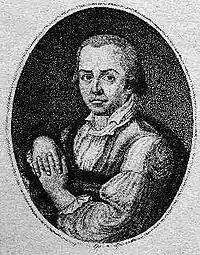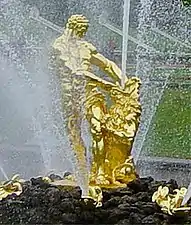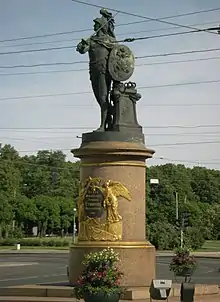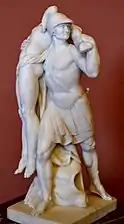Mikhail Kozlovsky | |
|---|---|
| Михаил Иванович Козловский | |
 Mikhail Kozlovsky (1790-1800s) | |
| Born | October 26, 1753 Saint Petersburg, Russian Empire |
| Died | September 18, 1802 (aged 48) Saint Petersburg, Russian Empire |
| Education | Member Academy of Arts (1794) Professor by rank (1799)[1] |
| Alma mater | Imperial Academy of Arts (1773)[1] |
| Known for | Sculpture |
| Awards | |
Mikhail Ivanovich Kozlovsky (Russian: Михаил Иванович Козловский; 6 November 1753 – 30 September 1802) was a Russian Neoclassical sculptor active during the Age of Enlightenment.
Biography
Beginning his training at the Imperial Academy of Arts with Anton Losenko in 1764, he went to Rome in 1774 and then to Paris in 1779. Although his early works harked back to the Baroque sensibility, Kozlovsky eventually succeeded in adapting his manner to Neoclassical monumentality. In 1788, he returned to Paris with the task of superintending Russian students abroad. He was appointed a professor at the Academy of Arts in 1794 and instructed young sculptors in St Petersburg until his death.
Among his classicizing works was the awesome gilt bronze statue of Samson Rending the Lion's Jaws (1800–1802), a central piece of the Grand Cascade at Peterhof Palace, symbolizing Russia's victory over Sweden in the Great Northern War. After it was looted by the invading Germans, a replacement statue was installed in 1947. Another masterpiece is the Suvorov Monument, an expressive bronze sculpture of Generalissimo Alexander Suvorov in the guise of youthful Mars. It was unveiled in the Field of Mars (Saint Petersburg) a year before the sculptor's death.
Works
 The sculpture of Samson in the central fountain of Peterhof Park
The sculpture of Samson in the central fountain of Peterhof Park
_by_shakko_05.jpg.webp) Eros (1797)
Eros (1797)_by_shakko_02.jpg.webp) Jacob Dolgoruky, burning royal decree (1796)
Jacob Dolgoruky, burning royal decree (1796)
_01.jpg.webp) Polycrates (1790)
Polycrates (1790)
References
Bibliography
- С. Н. Кондаков (1915). Юбилейный справочник Императорской Академии художеств. 1764-1914 (in Russian). Vol. 2. p. 258.
External links
![]() Media related to Mikhail Kozlovsky at Wikimedia Commons
Media related to Mikhail Kozlovsky at Wikimedia Commons